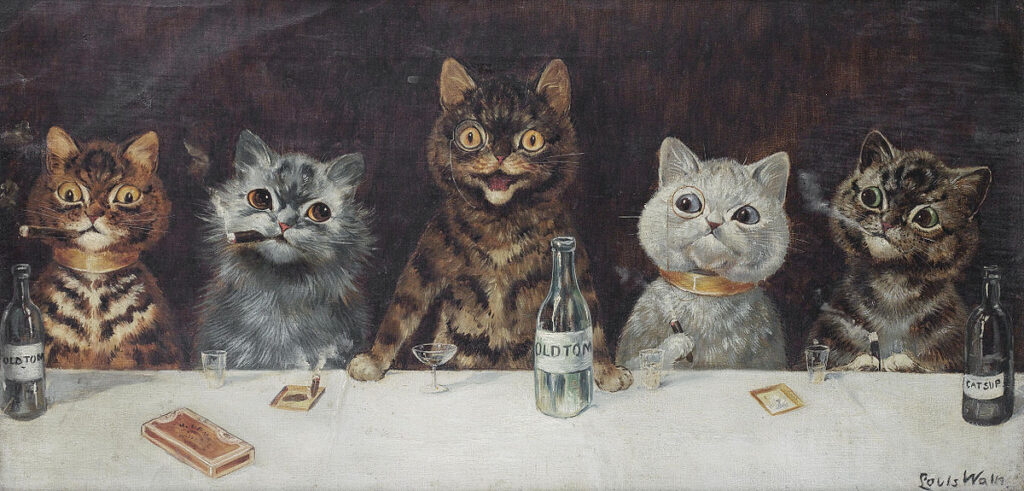Let’s embark on a delightful journey through the captivating world of Louis Wain, the artist who brought cats to life with a unique blend of charm and humor. His renowned work, “The Bachelor Party,” serves as a brilliant showcase of Wain’s ability to infuse joy and personality into his feline characters. In this extended exploration, we’ll delve into the life of Louis Wain, trace the contours of his career, unravel the nuanced details of “The Bachelor Party,” and uncover fascinating facts about this whimsical masterpiece.
Who was Louis Wain?

Louis Wain, born in 1860 in London, was an artist whose name became synonymous with imaginative cat illustrations. His early career found roots in freelance work for various periodicals and magazines, where he demonstrated a keen eye for capturing the essence of cats in his drawings. Wain’s cats weren’t mere animals; they were endowed with human-like expressions and behaviours that set his work apart and captured the hearts of art enthusiasts.
FUN FACT: Louis Wain, known for his whimsical and anthropomorphic cat illustrations, was also a prolific inventor. In addition to his artistic talents, he patented several inventions, including a mouse trap and various mechanical devices.
Wain’s Career
Louis Wain’s artistic journey gained momentum when he started contributing illustrations to “The Illustrated Sporting and Dramatic News.” His quirky depictions of cats quickly gained popularity, paving the way for a prolific career focused on feline art. Despite facing personal challenges, including periods of mental health struggles, Wain’s commitment to his craft remained steadfast.
Unpacking The Bachelor Party

| Artist | Louis Wain |
| Date Created | Early 20th century |
| Medium | Oil on canvas |
| Genre | Humorous Animal Art |
| Period | Victorian/Edwardian era |
| Dimensions | Not specified |
| Series/Versions | Part of Wain’s cat-themed portfolio |
| Where is it housed? | Private collections and galleries |
“The Bachelor Party” serves as a microcosm of Louis Wain’s artistic prowess, offering viewers a delightful window into his imaginative world. The composition of the painting is carefully crafted, with each cat playing a distinct role in the festivities. This painting was created during Victorian/Edwardian era. The whimsical nature of the scene, combined with Wain’s signature anthropomorphism, creates a harmonious blend of the familiar and the fantastical.
The cats in the painting are adorned in a variety of costumes, ranging from formal wear to more casual attire. Wain’s attention to detail is evident in the way he captures the nuances of each cat’s expression and posture. Some cats are engaged in lively dances, showcasing a sense of movement and rhythm, while others are immersed in the joyous act of making music with an assortment of instruments.
The color palette employed by Wain contributes significantly to the overall vibrancy of the painting. Bold and contrasting colors create a dynamic visual experience, drawing the viewer’s attention to the lively interactions among the feline characters. Wain’s use of color isn’t just about aesthetics; it serves as a tool to convey the exuberance and energy of the celebration.
Interesting Facts about The Bachelor Party
A Whirlwind of Fun: “The Bachelor Party” is a whirlwind of feline festivity. The cats in the painting are doing everything from playing instruments to dancing, creating a lively and joyous atmosphere that radiates off the canvas.
Splash of Colors: Wain’s use of a vibrant and bold color palette adds to the celebratory mood of the painting. The colors pop, creating a visually engaging experience and emphasizing the playful nature of the scene.
Art Amidst Adversity: It’s noteworthy that “The Bachelor Party” was created during a period when Wain was grappling with mental health issues. Despite personal challenges, the artwork stands as a testament to his resilience and his ability to create uplifting and whimsical scenes.
Cat Carnival: The painting is like a carnival of cats, each one with its own unique personality and role in the festivities. Wain’s attention to detail in portraying the individuality of each cat adds depth to the overall composition.
Legacy of Joy: Louis Wain’s cat art has left an enduring legacy. His ability to bring humor and joy into his illustrations has influenced generations of artists and continues to captivate audiences, making his cat-themed works highly collectible.
Artwork Spotlight: The Enchanted Garden

“The Enchanted Garden” by Louis Wain depicts his famous whimsical cats romping in a beautifully landscaped garden surreal surroundings. Wain brings out his expressive demeanor in the way human-like cats interact not only amusing, but entertaining as well.
Frequently Asked Questions
What illness did Louis Wain suffer from?
The individual known for his cat illustrations bore witness to the various stages of schizophrenia, a condition that marked numerous periods throughout his life. Wain, born in 1860 in London, was unable to commence schooling until the age of 10 due to his physical frailty.
How much is a Louis Wain original worth?
Louis Wain’s artwork has appeared at auctions on numerous occasions, fetching prices that vary widely from 6 USD to 48,718 USD, contingent upon factors such as the dimensions and materials used in the creation of the piece. Since 1998, the highest recorded price achieved for one of Wain’s works at auction stands at 48,718 USD.
How long was Louis Wain married to his wife?
Wain had scant opportunity to celebrate his achievements with his wife; Emily passed away in January 1887, a mere three years into their marriage. Wain gained renown for his illustrations featuring anthropomorphized cats.
Conclusion
Louis Wain’s “The Bachelor Party” isn’t just a painting; it’s a portal to a world of whimsy and wonder, where cats reign supreme and celebrations abound. Through this extended exploration, we’ve peeled back the layers of Wain’s life and career, gaining insights into the man behind the art and the enduring legacy he left behind.













